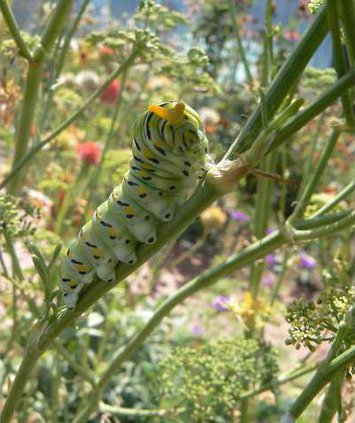It’s caterpillar season, and I don’t mean the machine kind. From bold and bright to dull and dark, smooth and slick to spikey and sticky, caterpillars are some of the most varied larva in the insect world.
The variety of caterpillar colors and forms prompted the late Dr. John Cody, known as the Audubon of moths for his realistic silk moth paintings, to muse that if he had another life to live, he’d paint caterpillars. Several caterpillars will be on display during KWEC’s Butterfly Festival Sept. 17, so you too can appreciate their diversity.
There are valid reasons for caterpillars’ different colors and form. Bold, bright colors often advertise bad taste or toxins, as in the classic case of the monarch caterpillar, sporting white, black and yellow stripes. Monarch caterpillars only eat plants in the milkweed family, which just happen to contain cardiac glycosides, distasteful chemicals that make birds sick. As the caterpillar eats the milkweed and grows, it stores more and more of the poison, making it more distasteful and poisonous to birds. This protection is retained in the adult butterfly.
Another butterfly, the viceroy, was thought to mimic the adult monarch’s bright orange and black coloration but be harmless. After further research however, it was discovered the viceroy caterpillar eats leaves in the willow family that contain salicylic acid, another chemical that makes birds sick. The two butterfly species are mimicking each other’s warning coloration, a condition called Müllerian mimicry.
The viceroy caterpillar is not brightly colored, instead it “hides” by using another form of mimicry, resembling bird droppings. Several caterpillars use this strategy, including the giant swallowtail and young black swallowtails.
Swallowtail caterpillars possess quite possibly the most interesting defense mechanism – osmeterium – or stink horns. Try touching or lightly tapping a black swallowtail caterpillar, right behind its head. Waving its head, out pops a bright orange forked scent gland. The gland exudes a strong odor that repels ants, small spiders and mantids.
Many caterpillars are covered in “hairs” that resemble fur, like the wooly bear caterpillar. Although some people forecast winter’s severity by the width of the woolly bear’s rust-colored bands, the actual purpose of the hairs is predator protection and helping it overwinter by freezing more predictably. The little hairs, or setae, freeze first, away from the caterpillar’s body, allowing it to remain frozen for longer periods of time.
By now, you’re appreciating all those caterpillars crawling on your plants and their struggle for survival, right? Well maybe not, but consider planting extra dill, parsley, violets, to continue enjoying both the caterpillars and the butterflies.
Caterpillar capers





